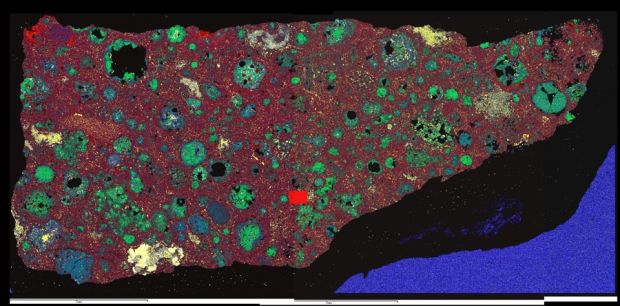The earliest rocks in the solar system, from which the terrestrial planets were born, were more like candy floss than hard rock, according to a new analysis carried out by a team including researchers in the UK and Australia. This is the first geological evidence to support the idea that the first solid material in the solar system was extremely porous before it was subsequently compacted into larger bodies, which become the planets we know today.
To get an idea of the type of primitive material that surrounded our young Sun, astrogeologists often look to the belt of asteroids that orbits between the paths of Mars and Jupiter – objects that did not coalesce into planets. These asteroids provide us with meteorites, including a class of rocks known as carbonaceous chondrites, which contain well-preserved material from the early solar system.
While geologists have scrutinized many of the chondrites that have fallen to Earth as meteorites, they have found it difficult to probe the internal structures because the grains are so fine. “With terrestrial rocks – like slate or sandstone – we can often see textures with the naked eye. But we can’t do that with the sub-micron material found in meteorites” says Philip Bland, one of the researchers at Imperial College, London.
Mexican fireball
To take a closer look at this grain structure, Bland and his colleagues analysed a sample from the Allende meteorite, which fell to Mexico in 1969, the largest carbonaceous chondrite ever discovered on Earth. They used a relatively new technique used widely in materials science known as electron back-scatter diffraction, which enabled them to resolve features of the grains’ structures down to 0.3 µm in size.
Then, from these images, Bland’s team invented a new method for quantifying the amount of compression that the rock has experienced throughout its lifetime in order to deduce its original structure. In the case of the meteorite sample, observing a “strong” internal fabric suggests that the rock was highly porous to begin with before its grains compressed into a highly ordered state. Using the method, the team found that the sample from the Allende meteorite used to be mostly empty space, with an initial porosity of 70–80%.
To explain what he means by fabric strength, Bland uses the analogy of a builder laying a batch of tiles. “If the tiles are laid out flat and well aligned we would say that they have a strong fabric. But if they are simply tossed randomly into a patch of mud then they would have a weak or non-existent fabric.”
The finding that this primitive rock had a very high original porosity matches well with recent computer models that predict that the seeds of planets (planetisimals) in the early solar system emerged from turbulence in the disc of dust that surrounded the young Sun. “Everyone is still struggling to understand planetesimal formation,” says William Bottke, an asteroid researcher at Southwest Research Institute in Boulder, Colorado.
Bottke believes these new findings support the idea that the seeds for planets emerged due to gravitational instabilities in the protoplanetary disc. “Once the planetesimals were made, a few would undergo runaway accretion to make protoplanets. The leftovers would become the asteroids and comets.”
Bland now intends to carry out further tests alongside his colleagues at the University of Liverpool and the Natural History Museum in the UK, and Curtin University and CSIRO in Australia. He hopes they can uncover further details about the features involved in planet growth including the process of runaway accretion.
These findings are reported in Nature Geoscience.
Read more interesting blog articles here.



